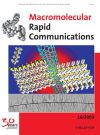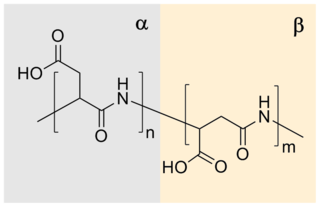Polymer chemistry is a sub-discipline of chemistry that focuses on the structures of chemicals, chemical synthesis, and chemical and physical properties of polymers and macromolecules. The principles and methods used within polymer chemistry are also applicable through a wide range of other chemistry sub-disciplines like organic chemistry, analytical chemistry, and physical chemistry. Many materials have polymeric structures, from fully inorganic metals and ceramics to DNA and other biological molecules. However, polymer chemistry is typically related to synthetic and organic compositions. Synthetic polymers are ubiquitous in commercial materials and products in everyday use, such as plastics, and rubbers, and are major components of composite materials. Polymer chemistry can also be included in the broader fields of polymer science or even nanotechnology, both of which can be described as encompassing polymer physics and polymer engineering.

Hermann Staudinger was a German organic chemist who demonstrated the existence of macromolecules, which he characterized as polymers. For this work he received the 1953 Nobel Prize in Chemistry.

Polymer science or macromolecular science is a subfield of materials science concerned with polymers, primarily synthetic polymers such as plastics and elastomers. The field of polymer science includes researchers in multiple disciplines including chemistry, physics, and engineering.

Methyl trifluoromethanesulfonate, also commonly called methyl triflate and abbreviated MeOTf, is the organic compound with the formula CF3SO2OCH3. It is a colourless liquid which finds use in organic chemistry as a powerful methylating agent. The compound is closely related to methyl fluorosulfonate (FSO2OCH3). Although there has yet to be a reported human fatality, several cases were reported for methyl fluorosulfonate (LC50 (rat, 1 h) = 5 ppm), and methyl triflate is expected to have similar toxicity based on available evidence.

Applied Organometallic Chemistry is a monthly peer-reviewed scientific journal published since 1987 by John Wiley & Sons. The editor-in-chief is Cornelis J. Elsevier.

The Journal of Raman Spectroscopy is a monthly peer-reviewed scientific journal covering all aspects of Raman spectroscopy, including Higher Order Processes, and Brillouin and Rayleigh scattering. It was established in 1973 and is published by John Wiley & Sons. The editor-in-chief is Laurence A. Nafie.

Ulrich Sigmar Schubert is a German chemist and full professor for Organic and Macromolecular Chemistry at the Friedrich-Schiller University Jena.

Macromolecular Rapid Communications is a biweekly peer-reviewed scientific journal covering polymer science. It publishes Communications, Feature Articles and Reviews on general polymer science, from chemistry and physics of polymers to polymers in materials science and life sciences.

Macromolecular Bioscience is a monthly peer-reviewed scientific journal covering polymer science. It publishes Reviews, Feature Articles, Communications, and Full Papers at the intersection of polymer and materials sciences with life science and medicine. The editorial office is in Weinheim, Germany. The editor-in-chief is Anne Pfisterer. According to the Journal Citation Reports, the journal has a 2020 impact factor of 4.979.
Macromolecular Reaction Engineering is a peer-reviewed scientific journal published monthly by Wiley-VCH. The journal covers academic and industrial research in the field of polymer reaction engineering, which includes polymer science. It emerged from a section that was part of Macromolecular Materials and Engineering. The journal publishes reviews, feature articles, communications, and full papers in the entire field of polymer reaction engineering, including polymer reaction modeling, reactor optimization, and control. Its 2020 impact factor is 1.931.

Institut Charles Sadron is a research center of the Centre national de la recherche scientifique, associated with the University of Strasbourg, which was created in 1954 to answer the demand for fundamental research in the emerging field of polymer science.

Polyaspartic acid (PASA) is a biodegradable, water-soluble condensation polymer based on the amino acid aspartic acid. It is a biodegradable replacement for water softeners and related applications. PASA can be chemically crosslinked with a wide variety of methods to yield PASA hydrogels. The resulting hydrogels are pH-sensitive such that under acidic conditions, they shrink, while the swelling capacity increases under alkaline conditions.
Kaushal Kishore (1942–1999) was an Indian polymer chemist and head of the department of inorganic and physical Chemistry at the Indian Institute of Science (IISc). He was known for his researches on thermochemistry and combustion of polymers. and was an elected fellow of the National Academy of Sciences, India, Indian National Science Academy, and the Indian Academy of Sciences. The Council of Scientific and Industrial Research, the apex agency of the Government of India for scientific research, awarded him the Shanti Swarup Bhatnagar Prize for Science and Technology, one of the highest Indian science awards, in 1988, for his contributions to chemical sciences.
Brigitte Voit is a German chemist and professor of chemistry. She holds the chair Organic Chemistry of Polymers at the Faculty of Chemistry of the TU Dresden and is head of the Institute of Macromolecular Chemistry at the Leibniz Institute of Polymer Research in Dresden. From September 1, 2002 to July 31, 2022 she was also member of the Board of Management/CSO of the IPF Dresden.
Anne Hiltner was an American polymer scientist who founded the Center for Applied Polymer Research (CAPRI) and was later instrumental in the founding of the Center for Layer Polymeric Systems (CLiPS), a National Science Foundation Science and Technology Center at Case Western Reserve University. She served as Director of the Center for Layered Polymeric Systems from its founding in 2006 until her death in 2010.
Christopher Barner-Kowollik FAA, FQA, FRSC, FRACI is an Australian Research Council (ARC) Laureate Fellow, the Senior Deputy Vice-Chancellor and Vice-President (Research) of the Queensland University of Technology (QUT) and Distinguished Professor within the School of Chemistry and Physics at the Queensland University of Technology (QUT) in Brisbane. He is the Editor-in-Chief of the Royal Society of Chemistry (RSC) journal Polymer Chemistry, a principal investigator within the Soft Matter Materials Laboratory at QUT and associate research group leader at the Karlsruhe Institute of Technology (KIT).

Katja Loos is professor at the Zernike Institute for Advanced Materials of the University of Groningen, The Netherlands holding the chair of Macromolecular Chemistry and New Polymeric Materials.

Christoph Weder is the former director of the Adolphe Merkle Institute (AMI) at the University of Fribourg, Switzerland, and a professor of polymer chemistry and materials. He is best known for his work on stimuli-responsive polymers, polymeric materials that change one or more of their properties when exposed to external cues. His research is focused on the development, investigation, and application of functional materials, in particular stimuli-responsive and bio-inspired polymers.
Vitaliy Khutoryanskiy FRSC is a British and Kazakhstani scientist, a Professor of Formulation Science and a Royal Society Industry Fellow at the University of Reading. His research focuses on polymers, biomaterials, nanomaterials, drug delivery, and pharmaceutical sciences. Khutoryanskiy has published over 200 original research articles, book chapters, and reviews. His publications have attracted > 10000 citations and his current h-index is 48:. He received several prestigious awards in recognition for his research in polymers, colloids and drug delivery as well as for contributions to research peer-review and mentoring of early career researchers. He holds several honorary professorship titles from different universities.












